Matador Network's Blog, page 1172
January 30, 2019
O’Hare getting $8.5 billion makeover

If you fly regularly around the United States, there’s a good chance that you’ve passed through Chicago O’Hare International Airport — it’s the sixth busiest airport in the world by passenger volume with 80 million passengers annually. Because it’s so busy and wants to offer travelers the best possible experience, ORD is planning an $8.5 billion makeover that will grow the overall terminal square footage by more than 60 percent and increase gate frontage by 25 percent by 2026.
To make sure that those who actually use the airport are satisfied with the changes, ORD set up a design competition for the terminal expansion, and you can vote for your favorite one. There are currently five design teams remaining, so check them out and make your choice to be part of Chicago O’Hare International Airport’s future.
Design 1: Fentress-EXP-Brook-Garza

Photo: O’Hare 21
“The Fentress-EXP-Brook-Garza Joint Venture’s globally minded terminal design for Chicago provides an elegant, spacious, and sustainable gateway to connect Chicagoans and the world with speed and efficiency. Soaring spaces sparkle with sunlight and lift the human spirit. Daylight and spatial composition guide passengers intuitively and purposefully. The latest technological advances shape a smart, seamless, comfortable, and unencumbered experience. From arrival to departure, every element of the new terminal is crafted to elevate the passenger, making their journey inspiring, engaging, stirring, and fun. Our vision is to return the romance of air travel to all who pass through Chicago’s O’Hare.”
Design 2: Foster Epstein Moreno JV

Photo: O’Hare 21
“Our design is based upon a sequence of memorable and distinctive spaces that create a gateway to Chicago with architecture that is open, transparent, inclusive, welcoming, and functional, in turn resolving the sophisticated security, airport, and airline requirements in a way that meets the needs of both employees and passengers. Three arches frame the landside of the building, merging into a grand single arch on the airside, thus dissolving the barrier between inside and out and allowing the spectacle of the airfield to be visible to all who pass through the gateway, and recapturing the romance associated with air travel.”
Design 3: Studio ORD

Photo: O’Hare 21
“Chicago is a city defined by motion; confluence — of our river, of trail networks, of railroads — has shaped our most vibrant civic spaces. Studio ORD’s elegant and efficient design for the O’Hare Global Terminal and Global Concourse unifies the airport’s campus by converging seamless lines of motion across three terminals around a spectacular central Oculus. This confluence becomes Orchard Field — a vibrant neighborhood that combines abundant green spaces with distinctive landmarks, bespoke retail pavilions, and diverse activity zones. Richly layered and easily navigable, it captures the unique character of Chicago and redefines O’Hare as a 21st-century international destination.”
Design 4: Skidmore, Owings & Merrill LLP

Photo: O’Hare 21
“We have delivered global excellence in this great city, shaping Chicago’s skyline, neighborhoods, and public realm for more than 80 years. It’s said that our Chicago buildings turn ‘pragmatism into poetry.’ Our elegantly undulating O’Hare Global Terminal aims to be the world’s best, through optimal functional planning, great design, and keen practicality — all quintessential Chicago qualities. We infuse the muscular heritage of Chicago architecture and engineering with many lessons from the natural environment to increase human comfort, save energy, and define a distinctive sense of place. This can be Chicago’s next great building and our new gateway to the world.”
Design 5: Santiago Calatrava, LLC

Photo: O’Hare 21
“O’Hare’s Global Terminal by Santiago Calatrava is a masterwork of modern terminal architecture. With a glass façade and dramatic shell-like roof soaring over the approach road, the building unifies the terminal complex while establishing itself as its centerpiece. Inside, vaulted, light-filled spaces celebrate both the grandeur and simplicity of bygone travel as customers move easily to and from gate areas enlivened by Chicago-focused concessions in an airy, park-like setting. Convenient links to adjacent terminals, satellite concourses, and public transit support a future Vision plan that transforms the area opposite the Terminal into a vibrant hotel, retail, and business complex.”
For more details and to vote for your favorite design, visit the project’s official website. 

More like this: The 10 best airports in Europe to travel through
The post Vote for your favorite design for Chicago O’Hare International Airport’s $8.5 billion makeover appeared first on Matador Network.

Must-see Carnival festivals in Italy

For a few weekends in February or March each year, Italy sees deep-fried pastries produced in droves, giant papier-mâché floats parading through towns, and a whole lot of confetti. These are all ways in which Italy celebrates Carnival, or Carnevale in Italian, before the beginning of Lent.
The name derives from the Latin, carnem levare, meaning to eliminate meat. As such, Carnival is the last chance to indulge in food, festivities, and a fair few illicit activities before the period of abstinence and sobriety during Lent. While some traditions like masked gambling in Venice are no longer part of the festivities, several cities around Italy still go all out with their pre-Lent extravagance. Here are some of the best Carnival festivals in Italy, including a fight with oranges, enormous mechanized papier-mâché politicians, and a flying angel.
1. Cento
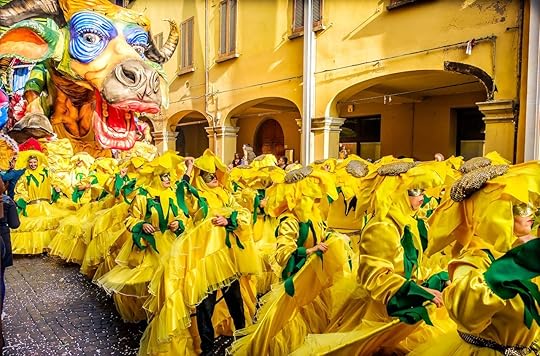
Photo: Luca Lorenzelli/Shutterstock
Though it likely has older origins, the Carnival of Cento really took off in the ‘80s and ‘90s, and its subsequent twinning with the Rio de Janeiro Carnival rocketed it to international fame. Following the traditional Carnival model, Cento’s pièce de résistance is its parade of giant papier-mâché floats. Each of the five Carnival Societies is responsible for creating a float, many of which play on current news issues (Donald Trump with chimp friends made an appearance one year). These all-singing, all-dancing masterpieces have moving parts and confetti cannons, and carry costumed dancers and performers.
The highlight for children visiting the Carnival is the gettito, the moment when the performers on the floats begin throwing free gifts and hundreds of sweets into the crowd. Cento’s festivities also include visiting dancers from Rio and a surprise celebrity appearance.
Visit on the last Sunday of Carnival for the climax of the festival, when the winning float is announced and a bonfire where the typical carnival mask is burnt (according to tradition) occurs. All this is followed by a firework display.
Dates: Parades take place on February 10 and 17, and March 3 and 10.
2. Ivrea

Photo: Paolo Bona/Shutterstock
Over the centuries, various quirky traditions have become incorporated into Carnival festivities, but none is more intriguing than Ivrea’s Battle of the Oranges. For three days, a battle rages throughout the streets and squares of Ivrea’s old town, with several hundreds of tons of oranges used as ammunition.
The battle is fought between soldiers of a medieval tyrant riding in horse-drawn carriages and rebels on the ground. Legend has it that it commemorates the overthrowing of a tyrant by the people of the town, after the milliner’s daughter chopped off his head when he attempted to exercise his droit du seigneur. It’s a violent and messy affair, and it makes for an exhilarating afternoon cheering on the rebels while dodging flying oranges.
Don’t forget to join the bruised and battered soldiers after the fight as they congregate in bars covered floor-to-ceiling in newspaper and cardboard in an attempt to protect against the invasion of orange pulp. Celebrations continue well into the night.
During the weekends leading up to the battle, there are also historical processions and traditional food stalls. To try a special Carnival dish, stop by the Bean Feast for an early morning bowl of steaming, hot beans.
Dates: February 6 to March 6 (Battle of the Oranges is March 3 to 5)
3. Viareggio

Photo: Sara Corso/Shutterstock
Viareggio is Italy’s most revered Carnival, and it takes its celebrations so seriously that it has created a “Citadel,” or carnival town, with vast warehouses where the floats are constructed, a Carnival museum, and a central elliptical arena that now hosts concerts and events.
During the month of Carnival, the whole town is infected with carnival fever. Popular bars and restaurants host fancy dress parties, traveling theatre groups give performances, and folk music, food stalls, and mask vendors are in abundance.
The highlight of the event, however, is the parade of papier-mâché floats along the seaside avenue. There are no barriers, so performers mix in with the crowd and you can get right up close to the floats, many of which play on allegorical and satirical themes.
Dates: Parades take place on February 9, 17, and March 3 and 5.
4. Acireale

Photo: solosergio/Shutterstock
The Sicilian Baroque town of Acireale can claim Carnival origins as old as the 16th century. Its earliest celebrations, however, were soon banned as they involved tossing rotten eggs and citrus fruits at people in the streets. Luckily, the 19th and 20th centuries saw the development of horse-drawn carriages parading through the streets, which evolved into the papier-mâché floats seen today.
Highly ornate, and often quite satirical, Acireale’s illuminated float creations are real works of art, with an extraordinary amount of detail. Indeed, Acireale is widely considered the most beautiful of Italy’s Carnival celebrations. The parade also features a special flower-adorned float, which is the winner of the preceding springtime Carnevale dei Fiori, another event that shouldn’t be missed.
Alongside the fantastical parades, there are acrobatic displays, buskers, DJ sets, and dance shows.
Dates: February 17 to March 5
5. Venice

Photo: Samot/Shutterstock
Internationally renowned Venice Carnival can easily be considered in a league of its own when it comes to pre-Lent celebrations. Indeed, if you want to experience some of that darker, secretive side of Carnival then you need to spend an evening in Venice, wandering from bar to bar through dimly lit streets traversed by shadowy, masked figures.
During the day, there is a vast array of events, from the costume parades to the Flight of the Angel, when a beautiful woman flies across St Mark’s Square. Pop into some bakeries, too, to sample Carnival pastries which are nearly all deep fried.
But make sure you stay on into the evening, don a mask, and follow the trail of confetti out of St. Mark’s Square and into the quieter areas of the city. Just as in the old days, Venice Carnival is the chance to become anonymous and lose yourself in the crowd of revelers.
Dates: February 6 to March 5
6. Comacchio
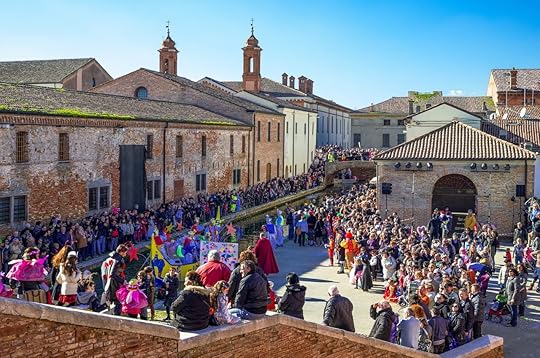
Photo: Gimas/Shutterstock
Comacchio is another aquatic city a little south of Venice, and it uses its waterways as the location for its carnival parade. The decorative themes of the parading boats remain a secret until the first weekend of Carnival, but previous years have included everything from Minions to Greek gods. The best place to watch the parade passing is from Comacchio’s iconic Trepponti, or three bridges, which is a kind of bridge crossroads where four different canals meet.
This is a more local celebration on a smaller scale, but that shouldn’t put you off. It’s a real family affair, with children dressed up and receiving little gifts from the Carnival King, and it’s not overrun with tourists like Venice Carnival. To really get involved in the celebrations, make sure you arm yourself with a bag of coriandoli, or confetti in English, to throw at unsuspecting victims.
Dates: Parades take place on February 24 and March 3. 

More like this: The wines to drink with 7 iconic Italian dishes
The post The 6 must-see Carnival festivals in Italy appeared first on Matador Network.

Polar vortex brings freezing temps

We’ve reached that stage of winter when there’s so much snow and the temperatures are so low that it’s pretty difficult to remember what summer felt like. The United States is in the midst of a polar vortex — a weather system bringing bone-chilling temperatures to many parts of the country. In much of the Midwest, particularly Illinois, Michigan, and Wisconsin, subzero temperatures have forced hundreds of school closures, and caused governors to declare emergencies. The high temperature in Des Moines, Iowa today will be minus 10 degrees, while the average winter high at Antarctica’s McMurdo Station is generally a balmy minus 6.
Many states are under chill warnings or advisories, as it’s possible to get frostbite in as little as five minutes without proper skin-covering clothing. In Minneapolis-St. Paul, for example, the wind chill is expected to be as low as minus 45 to minus 65 until Thursday morning.
And if you thought cold weather wasn’t enough to cause flight cancellations, think again. On Monday, 1,986 flights were canceled across the country due to the frigid weather, including a whopping 1,400 that were supposed to fly in or out of Chicago. According to CNN, “Amtrak also canceled all service to and from Chicago on Wednesday due to weather.”
Since falling temperatures have forced several universities across the Midwest to cancel classes this week, the only people happy about the polar vortex may be college students. 
H/T: The New York Times

More like this: The 10 weirdest winter sports you never knew existed
The post The polar vortex hitting the US with brutal temperatures can give you instant frostbite appeared first on Matador Network.

January 29, 2019
Water sports in Central America

Between the two huge land masses of North and South America lies tiny Central America. Barely wider than the state of Mississippi yet almost as long as Mexico, this subcontinent between giants packs an adventurous punch. There’s gurgling volcanos, luscious forests, and challenging hikes, but for water lovers, it’s truly a dream. There are 3,000 miles of prime Caribbean Sea and Pacific Ocean real estate and exceptional freshwater options, as well. You can paddle across vast lakes between towering mountains, carve down crowd-free glassy walls of water, traverse above coral reefs of lightning-bright colors, and find wind power to fill anybody’s kite with enough energy for some serious airtime. The region offers every aquatic endeavor you could want, and overland travel between different countries is relatively quick, cost-effective, and easily managed — when planned right. Here’s the best place to go, depending on your favorite watersport, and how to make the most of it.
Stand-up paddleboarding: Lake Atitlan, Guatemala
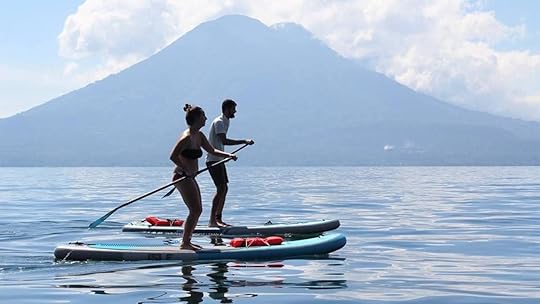
Photo: Stand Up Paddle Atitlan/Facebook
Just across the Mexican border, in the lush mountains of Guatemala, lies a 50-square-mile bowl of water, rimmed by sheer cliffs that rise into multiple volcanos. Lake Atitlan’s crinkly outline and steep sides provide shelter on even some of the windiest days, making this a perfect spot for paddle boarders of all experience levels. Because Atitlan has yet to be officially designated the world-class SUP destination it is, you’ll most likely find yourself stroking its fresh waters alone. You’ll also find a few places to rent stand-up boards, like SUP Atitlan.
While most people come here to attend the world’s cheapest, most spectacularly located Spanish schools, those coming for the water sports won’t be disappointed with the prices either. Keep in mind that at around three or four in the afternoon, a gnarly wind is likely to whip up out of nowhere. April to June and August to October are the calmest months on the lake.
Scuba: Utila, Honduras
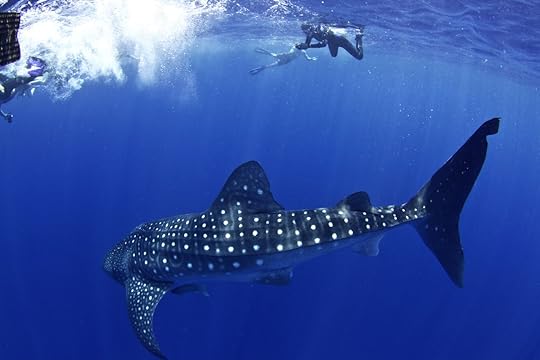
Photo: Joanne Weston/Shutterstock
Amongst professional scuba instructors, the Bay Islands in Honduras are considered to have world-class training at competitive pricing. From open water courses right through to Master Scuba Diver Trainer and beyond, the schools on these two main islands have refined their operations to an exact science. In terms of dive courses and trips, the cheapest of the two green specks in the Caribbean Sea is smaller island Utila. There, you’ll not only have a pick of many accredited dive schools — the best of which are affiliated with whale shark research centers — but there is also a much healthier underwater experience to find here than around its larger counterpart.
The coastline of Utila is protected on one side by humongous cathedrals of vibrant coral reefs. On the other, steep drop-offs descend straight down into the dark abyss. Those are natural features that impress at any time. However, come at the right time of year and your scuba or snorkel mask will also be treated to whale sharks marauding between slits of sunlight, dolphins breaching through flat calm seas, and turtles taking lazy laps around the seven-mile length of land. October through December and March through April will be your best chance to see all three.
Surfing: Nicaragua coast

Photo: LMspencer/Shutterstock
Neatly sandwiched in the middle of Central America, this incredibly diverse country brings together some of the best scenic and cultural features of the whole region. On the eastern coast, explorers will find few stereotypical Caribbean-style beaches where speakers of Miskito Creole serve up succulent lobster tails for just a couple of bucks.
The sapphire gem in Nicaragua’s Central American crown is the sprawling western coast that seems constantly pummeled by a pumping Pacific swell. This is a surfer’s paradise. Let your feet carry you north from Playa Maderas, board under arm, life’s necessities laden on your shoulders, and good times almost certainly ahead. While many of the well-known surf breaks have been over-colonized by wave hugging pseudo-hippies, there are plenty of waves waiting just beyond the well-marked tourist epicenters.
After a soul-filling day of surfing or bodyboarding, there’s really only one way to finish: by cooking dinner on an open fire and camping under star-strewn skies. There are a couple of cost-effective campsites on and between Maderas and Playa Del Cinco. If you decide to camp for free on the sands, check tide and weather conditions first because a choppy sea could easily leave the senseless awash. Boards can be rented in the main town of San Juan Del Sur or at the most popular beaches for approximately $10 per day with discounts available for week-long rentals. For the best swells, hit those beaches from April to September.
Kitesurfing: Ometepe, Nicaragua
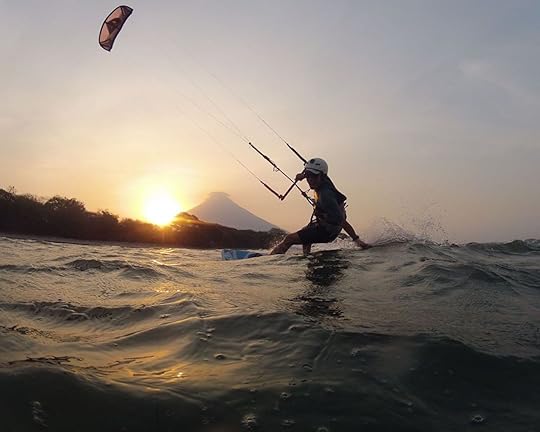
Photo: Sunkiteschool Nicaragua/Facebook
“Out of the midst of the beautiful Lake Nicaragua spring two magnificent pyramids, clad in the softest and richest green, all flecked with shadow and sunshine, whose summits pierce the billowy clouds. They look so isolated from the world and its turmoil — so tranquil, so dreamy, so steeped in slumber and eternal repose.” Famed traveler Mark Twain wrote this of the freshwater volcanic isle in 1866, and the quote is just as relevant today.
No matter the month, most arrivals will first be struck by the island’s famously fierce easterly winds, whipped up over a vast and seemingly infinite lake before being struck by the undeniable mystical beauty of Ometepe. Lake Nicaragua, the largest in Central America, whips up consistent winds that drive kite enthusiasts of all kinds to fill their canvas on the island’s unsheltered shore.
A key thing to know is that it’s not easy to traverse Ometepe without your own transport. By late 2018, there were only a handful of expensive taxis, an unreliable bus schedule, and one entrepreneurial tuk-tuk driver. Rental scooter your way to the east coast beaches, Santa Cruz and Domingo, to check out some seriously cheap accommodations. For just a couple dollars a night, I was able to rent a hammock in a rickety treehouse above the canopy with incredible island views dominated by the two cloud-topped volcanos, one of which is still active.
The island’s highly regarded kitesurfing school, Sun Kite School, offers lessons and gear rental at a wallet-happy price. Although there’s a good chance of wind year-round, serious kiters will find the most stoke between December and March.
Wakeboarding and windsurfing: Lake Arenal, Costa Rica

Photo: Parkol/Shutterstock
Deep in the northern highlands of Costa Rica, home to tapirs, sloths, and jaguars, you’ll find the country’s largest basin of water, Lago Arenal. Measuring 33 stretched-out square miles, the lanky lake funnels gusts from the heavens down its flanks. For this reason, the area has long been known as the windsurfing capital of Central America — able to fill sails enough for slow zips or quick whips in front of the awe-inspiring Arenal Volcano on most days of the week.
The lake’s edges jag and jut, providing ample opportunity for shelter from the wind — spurring the rise of a new water sport in the area. Wakeboarding has recently taken off in a big way, and you’ll be sure to find plenty of boats offering a tow at reasonable prices. Best time of year for wind and kitesurfing is November through April while August to October has the calmest months for wakeboarding. 

More like this: After falling from the brink of a tourism boom, Nicaragua is ready to welcome the world back
The post The absolute best spots in Central America for every water sport appeared first on Matador Network.

Ice climbing in Ouray, Colorado

Last winter, photographer Katie Botwin spent a day in the Ouray Ice Park in Ouray, Colorado. The park is made using the city’s overflow water to turn the Uncompahgre Gorge into a stunning wonderland of gleaming ice. The three miles of vertical terrain offer a range of options for expert climbers and first-timers. Below are stunning images from Katie’s trip, along with her tips for experiencing this epic trip yourself. 

1
Ouray, Colorado, a little town tucked into the San Juan Mountains that’s often called the “Switzerland of America,” is home to the remarkable Ouray Ice Park. Situated in the Uncompahgre Gorge, the Ice Park is a man-made wonder that is painstakingly recreated each winter.

2
Since the essence of ice climbing is swinging sharp, pointed tools into walls of ice, getting started can be a little intimidating. Taking lessons from a pro to learn the basics of ice climbing can help ensure you have a great time while keeping yourself and others safe. Here, Lindsay learns some essential rope management skills and how to tie an anchor.

3
When you show up to the Ice Park, you won’t be going for a typical stroll in the park. Winter in Colorado means frozen water and snow, and you are going ice climbing after all. You won’t necessarily need serious technical skills to get around, but you will need the proper equipment. Whether you’re bringing your own or renting from a place like San Juan Mountain Guides, be sure you have all of the technical gear you’ll need - like crampons and ice axes. Also, pack plenty of warm layers, water, and food.
Intermission
News
Traveling with your kids makes them better in school, new study says
Eben Diskin
Jan 10, 2019
News
Meet Kitty, this Aspen hotel’s new adorable mascot
Eben Diskin
Jan 18, 2019
Travel
How to explore breathtaking southern Greenland
Jorgo Kokkinidis
Jan 24, 2019
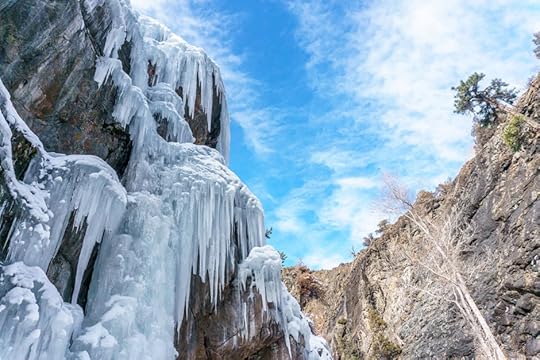
4
The Ouray Ice Park isn’t your everyday sight. You’re sure to see some breathtaking scenery while making your way around these incredible walls of ice.

5
The Ice Park is gravity fed, which means no pumps or motors are used to create what you’ll be digging your ice tools into soon enough. This means certain areas of the park can be closed while others are open, and while formations may look similar, they are never exactly alike and are always changing.

6
Safety is key while in the park. If you’ve never been, or are still starting out, a guide can help keep your group safe as well as everyone else in your vicinity. Check the park’s website for a listing of independent guide operations. Here, Chad practices how to tie a clove hitch knot.

7
Once you’ve mastered the safety skills and learned all about climbing techniques, you’re ready to sink your tools into the ice. The park offers routes for every skill level. To warm up and practice our technique, we start on a route with a little less vertical.
Intermission
News
A rare white reindeer was spotted in Norway, and it’s the cutest thing ever
Eben Diskin
Dec 6, 2018
Sponsored
10 things you didn’t know about Aurora, CO
Tim Wenger
May 24, 2018
Sponsored
16 views from around the world that will inspire you to book a trip NOW
Jacqueline Kehoe
Oct 15, 2018

8
Although the ice is human-made, the gorge itself is a glorious work of nature. When your arms need a break from climbing, you can enjoy a long walk. The stunning gorge and three-plus miles of frozen waterfalls will leave you in awe.

9
On our day in the ice park, the sun occasionally peaks through the thick gray cloud cover - giving the ice a glowing blue hue.

10
As the day continued, more groups show up, which makes safety even more essential. Climbing below someone can result in shards of icefall catching you unaware, or you letting loose an icicle onto someone below you. Going on a weekday in the early morning usually helps with crowds, but you can always expect others to be climbing.

11
Watching a skilled climber can help you learn how to climb more efficiently and smoothly. Though your forearms will inevitably begin to burn, learning how to properly engage your legs while climbing can help increase the number of laps you’re able to take. Above, Kerr gets playful with an ice pillar.

More like this: How to do an incredible backcountry hut trip through Colorado
The post How to climb Colorado’s beautiful and intimidating Ouray Ice Park appeared first on Matador Network.

Touring California's ghost towns
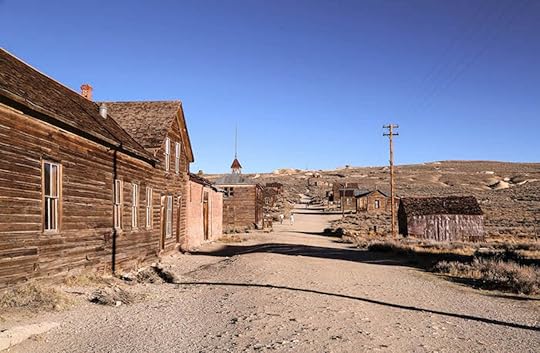
California has long been where people go to strike it rich. In the past, people came for gold — and to sell goods to those looking for gold. People now come for land ripe for vineyards, to become a Hollywood movie star, and, most recently, to strike it rich in the cannabis industry. These migrations have helped California become the richest and most populous state in the union. But they’ve also created a less seen side of the Golden State: ghost towns.
There’s an incredible number of ghost towns in California. Many are desolate with only a few building foundations left while others look like people got up and got out in a hurry, leaving everything in place. All provide a point of view most people miss when they visit California.
Joanna Kalafatis, an actress, writer, photographer, and Matador contributor, knows this all too well. Kalafatis has two books that document what it’s like to travel forgotten — and often dusty — California towns. The first is Abandoned Southern California: The Eras That Shaped the West, and the second is Abandoned Northern California: A Land of Contradictions. While road tripping across California, she’s seen snapshots of what life was like in the past.
We caught up with Kalafatis to learn why ghost towns are the best way to experience California in a way most people don’t know about.
Interview has been edited for clarity and length.
Why should travelers visit abandoned towns?
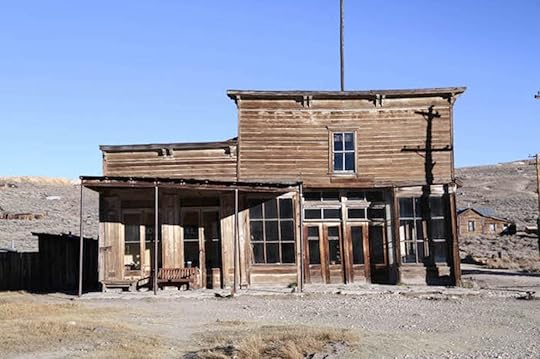
Photo: Joanna Kalafatis
When you have a whole town that’s abandoned, you can see the lifestyle of an era. You have abandoned schools, bars, churches, everything. It’s like an entire cross-section frozen in time.
The way I see it, abandoned towns are a very recent form of archaeology. What do archaeologists do to understand history? They go to abandoned places and find artifacts to get an understanding of how people used to live. For me, abandoned towns show an interesting real-life snapshot of a past era in time of a place that you’re visiting. You get to see something that might not be obvious in modern buildings of a city or town that makes it come to life.
Your books focus on California. Is there any part of California that’s an especially good area for abandoned towns?
Bodie has the most interesting buildings because it’s, I believe, the best-preserved ghost town in the entire US. So, for example, the abandoned school has books all over the place — obviously not in the greatest state — but also writing on the chalkboard. It’s preserved in a state of arrested decay. Looking inside, it’s like everyone just got up and left their things there.
It’s been classified now as a state park, so people are looking out to make sure it doesn’t fall to ruin. They’re not preserving it as it was, though; they’re preserving it as it was when they found it so it doesn’t fall into disrepair even more.

Photo: Joanna Kalafatis
Most of the towns that are around Bodie, which hit its peak in the 1860s and ‘70s, are in very rough parts of the state. They’re in deserts and mountains with high wind, cold, and heat, so they’ve fallen apart for the most part. Bodie has upwards of 40 buildings on site that are standing fully furnished. That’s a very rare thing to find from that long ago. Going to these towns you really do get a lot of sense of the details of that era because you see it first hand.
What makes northern California so apt for abandoned towns?
The waves of immigration. The gold rush, railroads, people using Route 66 to escape Depression in the east. There was the silver mining area, where a lot of towns sprung up and fell away in the same location. Same thing with the Mojave Desert towns that are all 40 minutes within each other.
Have you had any scares while exploring?
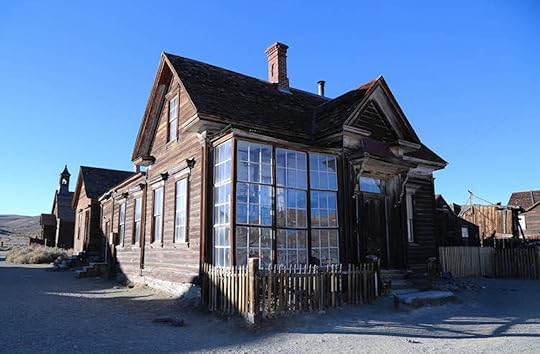
Photo: Joanna Kalafatis
I was photographing a town just a few minutes outside Randsburg. It looked completely abandoned and decayed, and I was photographing a house where half the roof was falling down and the door was off its hinges. It was quite dark inside — you couldn’t really see — and I had my camera up to my face. As I tried to zoom and focus and adjust the settings, I realized there’s an old woman staring back at me inside this abandoned building.
It was a real person — it was scary to see, “Oh I’m not alone and there’s someone looking at me now.”
What about ghosts?
Hospitals are always interesting because you have a lot of hallways and the extra creepy vibe.
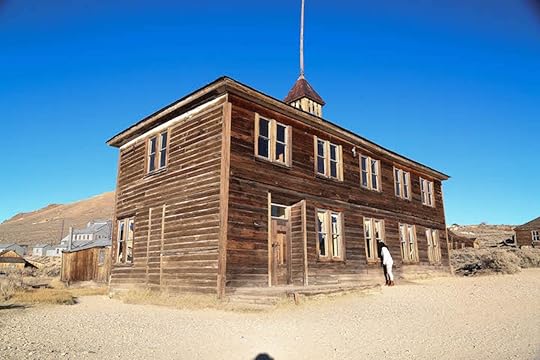
Photo: Joanna Kalafatis
I’m not personally a believer in supernatural things so much, but I’ve had a couple things where I’m like, “I would like to back away from this now.” When I was at the Camarillo State Mental Hospital, I was all the way inside and everything was abandoned in the 1990s, so there was a fair amount of furniture around. I get to this one room, and the light is on and the fan is going and these heavy desks had been turned onto their side. I saw that and was like, “Alright, I’m going to get out now.”
What should people know before visiting abandoned towns?
A lot of the abandoned towns in California are 90 percent abandoned, so there are some people somewhere in the town. And they tend to be very, how do I say it, thorny to outsiders. Be aware, be respectful, and don’t go onto private property. Always be aware and try to buddy up with someone.

Photo: Joanna Kalafatis
For a couple of places, make sure you have a car with four-wheel drive and go in full daylight. Don’t go during the winter. Some roads are dirt and get snowed in during the winter. Do your research beforehand to make sure the roads are open, the climate is right, and you have enough daylight to explore.
The last thing you want to do is get stuck in the middle of nowhere in an abandoned town with no way to get out. Not a great idea.
Any tips for people who want to photograph abandoned towns?
With abandoned buildings in general, you want to play on shadows and contrast. There’s a lot of that inherently around abandoned towns that gives them an interesting creepy vibe. You can’t rely so much on colors because a lot is faded and monotone. You have to create your own textures with shadow. That’s the number one tip.

Photo: Joanna Kalafatis
Most of this could be done using a solid camera like a nice mirrorless. Make sure you have a small cleaning kit because it can be dusty and grimy, and you’ll later find that things are on the lens. If you want to go the extra mile, rent a good wide angle lens to photograph the interiors of buildings, as it gives it a whole different dimension.
If there was one town that you wish was abandoned so you could photograph it, what would it be?
I’ve been to Tokyo and loved it, and it would be interesting to see Tokyo abandoned because part of what makes it what it is now is that it’s so crammed with people all over the place. It would be very fascinating to me to see a place like that completely abandoned and still and see what the city is like without millions of people there. 

More like this: Around the world in 15 abandoned cities
The post These photos will inspire you to road trip through California’s ghost towns appeared first on Matador Network.

Japan's cherry blossom season
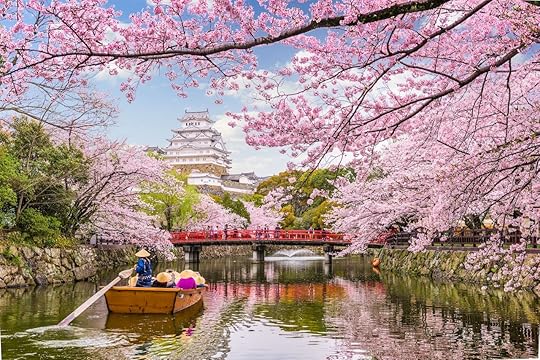
Known as sakura, the cherry blossoms in Japan are popular with both locals and tourists alike. For the Japanese, sakura hold much cultural and historical significance that goes deeper than obvious beauty. It’s one of the more well-known symbols of Japanese culture, and the blooming symbolizes human life, transience, and nobleness. It’s also tied to Shinto ideals of impermanence, hope, and renewal. In addition to being a metaphor for the beauty of life, the health of the blooming is used to discern the quality of that year’s harvest.
Cherry blossom season is one of the high seasons in Japan, and it’s easy to see why. The pink and white flowers found decorating the branches of sakura trees are utterly gorgeous, and it’s hard to not want to see them in all of their beauty. You’ll be surrounded by people no matter where you go to see them, but one of the best things about this time — aside from the cherry blossoms themselves, of course — is how respectful most people are toward each other. There’s a de facto understanding that everyone is there to enjoy unimpeded views of this natural wonder, so people try their best to see the flowers, get that perfect shot, and then let others enjoy the same courtesy. Here’s when to visit and where to go.
When to visit
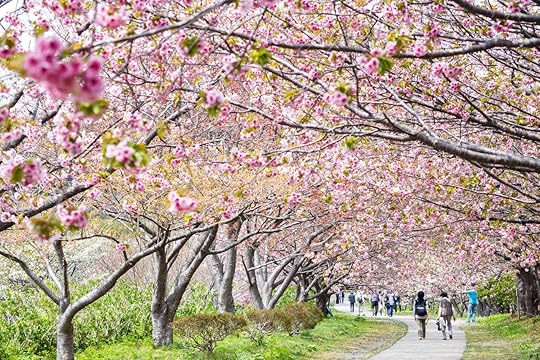
Photo: jajaladdawan/Shutterstock
Sakura are usually only in full bloom for about one week, after which they fall from the trees onto the ground. If you manage to catch the tail end of the blooming, you’ll be in for quite the treat — they’re so small and round that when they eventually start to fall, it’s almost as if you were watching snow gracefully descend from the skies.
The fact that they’re only in full bloom for such a brief period will undoubtedly cause stress over getting the timing right, but it’s actually pretty easy to plan your trip around the blooming and guaranteeing you’ll be able to catch it. While the cherry blossom season occurs between March and May each year, the specific time varies from region to region. Luckily, the Japanese Meteorological Corporation (JMC) has done all the work for the rest of us, and each year it posts a forecast detailing when the blooming will begin in each region in Japan. The predictions aren’t just looking at the weather months in advance; it also depends heavily on temperature patterns. Depending on how the patterns change over time, the JMC will release updated forecasts with the most up-to-date information.

Photo: Japan Meteorological Corporation
The forecast above lists 14 major prefectures, from as far up north as Hokkaido down south to Kagoshima, with a well-known city in each one, such as Sapporo and Tokyo. For each location, the JMC has listed an expected flowering and full bloom date, as well as the average flowering date (taken from past years). The JMC actually tracks the blooming for approximately 1,000 locations across the country, and although the website is originally in Japanese, there’s a Google Translate button right near the top of the site. The website even goes one step further and allows you to track the growth progress from budding to full bloom through a flowering meter.
The dates are unlikely to change too much, but give yourself a few extra days at each end of your trip to be safe.
Where to go
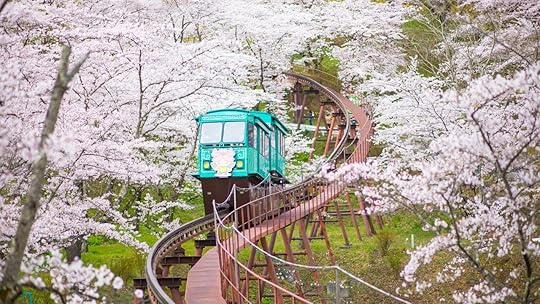
Photo: Phubet Juntarungsee/Shutterstock
Many people hold flower-watching parties, known as hanami. There are a number of celebrations held in honor of the cherry blossoms’ blooming, so you’re likely to find a hanami party no matter where or when you go. What makes up a hanami party, besides sakura viewing, is eating and drinking. Groups of people will set up camp in a park by a river — essentially wherever the cherry blossoms are — and have a picnic under the trees. Some bring home-cooked meals, some make food on the go while picnicking, and others buy already prepared food. And, as public drinking is legal in Japan, most people bring sake or another type of alcohol to mark the occasion.
Some of the best places to see the cherry blossoms:
Hokkaido: Goryokaku Park, Odori Park, Hakodate Park, Maruyama Park
Sendai: Tsutsujigaoka Park, Shiroishi Riverside, Mikamine Park
Tokyo: Shinjuku Gyoen, Ueno Park, Chidorigafuchi Park, Meguro River
Kyoto: Daigoji Temple, Heian Shrine, Philosopher’s Path, Yodogawa River Park
Hiroshima: Peace Memorial Park, Senkoji Park, Miyajima
Fukuoka: Nishi Park, Uminonakamichi Seaside Park, Fukuoka Castle Ruins
Of all the spots where you can see cherry blossoms, some of the most popular locations are Hokkaido, Tokyo, and Kyoto. Hokkaido is the northernmost island in Japan and is well known for its natural wonders, such as ponds with turquoise blue water, flower fields, waterfalls, and volcanoes. So it’s no surprise that an area abounding with such beauty will also be popular come springtime when the cherry blossom season begins. Tokyo is already a highly visited city in general and is included on most people’s itineraries when they visit Japan. Combining both Tokyo and sakura viewing is a great idea for making the most out of your time there, but you’re going to be sharing that experience with tons of other people. Kyoto is a remnant of an older time in Japan, and seeing a full bloom amidst the traditional architecture is an experience like no other, but many others will have the same idea.
While there’s nothing wrong with visiting the aforementioned locations, and most spaces are usually large enough that you never feel truly crowded, there are definitely some underrated spots that will ensure you have an experience free of the masses and are just as magical, if not more. The Miyagi Prefecture, in the Tohoku region, is one of them. Its capital city is Sendai, and while it’s the second largest city in Japan after Tokyo, the vibe is completely different — everything is much more relaxed and easygoing. It gets its fair share of visitors in the summer months but is often overlooked in favor of locations like Hokkaido, Tokyo, and Kyoto during the spring season. Fukuoka is another example, located on Japan’s Kyushu Island. Because of its southern location, it’s thought to be too far out of the way for some. But if you’re thinking of including Hiroshima on your trip, then Fukuoka is an easy trip away. Depending on what train you take, the ride can be anywhere between an hour and three, but it’s completely doable and you’ll get those sweet, unobstructed views. 

More like this: 9 Japanese sweet treats the world needs to know about and try
The post Everything you need to know about Japan’s 2019 cherry blossom season appeared first on Matador Network.

Bronz Zoo's Name-A-Roach program

Rather than putting your energy into a Burn Book or a carton of Ben and Jerry’s, you can take out your anger on your ex this Valentine’s Day by naming their spirit animal after them: a cockroach.
The Bronx Zoo is re-launching its “Name-A-Roach” program, which allows you to name one of over 50,000 giant Madagascar hissing cockroaches. For just $15, you can not only name a roach, but you can also send a certificate to the honoree.
While the internet is having fun maligning exes, the program is actually meant to celebrate the roach and be given as a Valentine’s Day gift to your significant other. According to John F. Calvelli, the Wildlife Conservation Society’s Executive Vice President of Public Affairs, “The Bronx Zoo’s Name-A-Roach promotion is a light-hearted, fun way to reach out to someone on Valentine’s Day to let them know that you are thinking about them.”
We dare you to bestow someone you actually care about with this honor as their only Valentine’s Day present and see how the holiday works out for you. But if you really think your special someone will get a kick out of having a roach named for them, you can also fork over $75 for “The Works” package, which includes a roach beanie, pin, and mug in addition to the certificate.
Regardless of who you name a roach after, it’ll all be for a worthy cause; all proceeds go to the Wildlife Conservation Society. 
H/T:

More like this: 5 places with the most dangerous animals in the world (that aren’t Australia)
The post Name a cockroach after your ex this Valentine’s Day at the Bronx Zoo appeared first on Matador Network.

Coolest libraries in the world

Nowadays, libraries are defined by electronic checkout systems, faulty printers, and labyrinths of bland, white rooms filled with ugly metal shelves. But because they are true temples of knowledge, libraries should be built to impress and be as grandiose as the volumes they host. Although there are only a few of them, such libraries exist. From libraries decorated with beautiful frescoes to those ornamented with amazing tiles, stucco work, or carvings, these visually stunning libraries would turn even the most recalcitrant readers into bibliophiles. Here are seven of the coolest libraries from around the world.
1. Library at the National Palace of Mafra, Mafra, Portugal

Photo: StockPhotosAr/Shutterstock
Located within the Palace of the Royal Building of Mafra, a cultural heritage site on the UNESCO tentative list, the Monastic-Royal Library is considered one of the most important European libraries as it contains a rare collection of about 30,000 volumes dating from the 15th to the 19th century, as well as incunabula (books printed between 1455 and 1501).
Not only does the 18th-century room host precious books, but its interior decor is also gorgeous. The very large library (about 278 feet long and 31 feet wide) with barrel vault ceilings was built in the shape of a cross, and its floor is covered in multi-colored tiles.
While most libraries go to great lengths to keep animals out, the Mafra National Palace Library actually invites them in. At night, bats are released inside the library to feed on book-eating pests that may damage the rare volumes.
According to the official website, “The Library is open to researchers, historians or scholars, whose object of study justifies the access to this collection,” but you can see the library if you take a tour of the palace.
2. Strahov Monastery Library, Prague, Czech Republic

Photo: Maciej Bledowski/Shutterstock
The Strahov Monastery Library is comprised of three rooms: the Theological Hall, the Philosophical Hall, and the Cabinet of Curiosity, all of which are stunners and contain invaluable volumes. The Theological Hall stores 18,000 volumes, most of which are different editions of the Bible or parts of the Bible in many languages, and the Philosophical Hall has 42,000 volumes on the topics of philosophy and the sciences.
Both the Theological and the Philosophical Halls are intricately decorated in a Baroque style with religiously inspired frescoes, stucco work, beautiful wooden shelves, and parquet. The Cabinet of Curiosities contains books, as well as glass cases displaying natural science collections, including the remains of a Dodo; archeological findings; and military exhibits. Located in the Strahov Monastery, the Strahov Library is easy to access during any visit to Prague and is open daily. Entry cost is $5.
3. Stockholm City Library, Stockholm, Sweden

Photo: Thorir Ingvarsson/Shutterstock
The City Library in Stockholm may look very modern, but it was actually built almost 100 years ago, between 1918 and 1927, by Gunnar Asplund, a world-famous Swedish architect. The outside of the building is simple enough (a cubic base topped with a cylinder) that it does not necessarily catch the eye of unsuspecting out-of-towners, but those who make it inside get rewarded for their curiosity by a stunning temple of culture.
Walk in and take the stairs all the way to the cylindrical part that is lined with tiered bookshelves, and you’ll understand the appeal instantly. You can go all the way up to the top bookshelves and admire this beautiful room from above. Perhaps the best part of this library is that it’s relatively unknown to tourists, so you can visit without having to deal with hordes of people snapping photos. There’s no entry fee to get in, but because it is a functioning library, you’ll have to be silent during your visit.
4. The Old Library at Trinity College, Dublin, Ireland

Photo: STLJB/Shutterstock
Trinity College’s Old Library might be most famous for housing the Book of Kells, the ninth-century illuminated Gospel manuscript that is considered one of Ireland’s national treasures, but there’s much more to this library than one ancient (albeit beautiful and incredibly rare) book. The Long Room of the Old Library, the most famous spot in Trinity College, is located upstairs from the exhibition room where the Book of Kells is displayed. It is a superb room filled with oak bookcases containing 200,000 of the library’s oldest books that seems to stretch for miles under an arched ceiling.
A visit to the Old Library and the exhibition of the Book of Kells is short and involves a fee (unless you know a Trinity College student who would be willing to accompany you and show their student card for you to get in). Once on the college’s grounds, make sure to explore the rest of the beautiful campus that is smack dab in the heart of the city.
5. Admont Abbey Library, Admont, Austria

Photo: Nat S. Retsu/Shutterstock
The Admont Abbey Library, built in 1776 in a seriously overwhelming European Baroque style, is the largest abbey library in the world. The library’s seven cupolas are decorated with stunning frescoes by Bartolomeo Altomonte. Stored below are about 70,000 volumes (the Abbey owns nearly 200,000 books in total) among limewood carvings by Josef Stammel, intricate columns, and a striking white and gold aesthetic. In 1865, a fire consumed almost the entire monastery, with the exception of the stunning library and its beautiful and rare volumes — phew! The Admont Abbey is also home to several museums that are worth checking out. The library is open to the public (with or without a guided tour) and is barrier-free.
6. The Boston Athenaeum, Boston, US

Photo: Boston Athenæum/Facebook
Built in 1807, the Boston Athenaeum is among the oldest and most distinguished independent libraries and cultural institutions in the United States. It added an art gallery in 1827, began running yearly exhibitions of American and European art, and by the mid-1800s found itself not only at the center of Boston’s culture scene but also one of the largest libraries in the US. Overlooking the Granary Burying Ground, a 17th-century cemetery, it currently houses over half a million volumes, many of which focus on Boston history. It also hosts an exhibition program, lectures, and even concerts, and in 1966, it was designated as a National Historic Landmark. The Athenaeum is a membership-only library with member fees starting at $220 per year, but it’s open for the public to visit or take a tour.
7. St. Peter-in-the-East, Oxford, UK

Photo: St Edmund Hall, University of Oxford/Facebook
An entire book could be written on the libraries of Oxford — the university city has over 100 libraries, making it the largest library system in the UK. The university’s main library, the Bodleian, is undoubtedly its most famous, but there are many other smaller libraries worth visiting. One of these is the library of St. Edmund Hall college, which is housed in the 12th-century church of St Peter-in-the-East, one of the oldest churches in the city of Oxford. The church was converted into a library in 1970, but the renovation process kept the integrity of the church intact — There is even a crypt below and a graveyard outside, but you won’t find any books there. The Library holds approximately 40,000 volumes. Outsider access to St. Peter-in-the-East is only allowed during school vacation periods. 

More like this: The 28 coolest independent bookstores in the US
The post The 7 coolest libraries around the world appeared first on Matador Network.

‘Harry Potter’ beer festivals coming

There’s no shortage of beer festivals in the US, but there has been a glaring, almost criminal, lack of Harry Potter-themed beer festivals. That’s about to change. Rock Star Beer Festivals is organizing a series of events dedicated to consuming our favorite alcoholic beverages in an environment designed to look like the world of Harry Potter. Venues will be decorated like the Leaky Cauldron, Diagon Alley, and Hogwarts’ Great Hall. Each location will serve alcoholic butterbeer as well as more than 20 different winter, pumpkin, and holiday ales. Naturally, there will be plenty of photo ops so all of your Instagram followers can be made sufficiently jealous.
According to the Facebook page for the Portland, Oregon event, the city will “transform the historic Castaway in Downtown Portland into the Wizarding World of Harry Potter complete with Hogwarts Great Hall, Diagon Alley, and the Leaky Cauldron…there will be a Hagrid photo op, plenty of characters, food from Mac Shack, and live music from the Slytherin Sisters and DJ Dumbledore.”
Rock Star Beer Festivals is organizing 11 total events in all, starting in Portland, Oregon, on February 1 (with additional dates on February 15 and 16). The following Beery Potter events are in Las Vegas (February 2), Denver (February 9 and 23), Phoenix (March 9), Seattle (March 15 and 16), Indianapolis (March 23), and Louisville (March 30). Festival details and where to purchase tickets can be found in the events section of Rock Star Beer Festivals Facebook page.
Tickets to the event cost $35. 

More like this: 7 cultural festivals you need to check out around the world
The post Harry Potter-themed beer festival coming to 11 cities around the US appeared first on Matador Network.

Matador Network's Blog
- Matador Network's profile
- 6 followers



